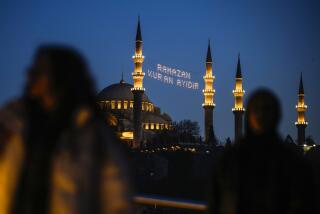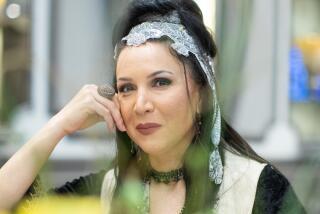WEEKEND REVIEWS : Dance : Forbidden Pleasures From Mevlevi Troupe
- Share via
How would Catholics feel if the Mass were outlawed except as a cultural performance--and then allowed only in theaters and gymnasiums rather than consecrated spaces? How would Jews feel if they were on public display as guardians of tradition, yet forbidden to worship?
Maybe the members of the Mevlevi Ensemble could tell us--if they dared. In 1925, Turkish Law No. 677 banned the ceremony and sect popularly known as the Whirling Dervishes.
Only in 1953 was a performance again authorized--in a movie house. The great blind singer Kani Karaca chanted the holy verses on that occasion and, on Saturday, Karaca’s soulful vocalism lent an extra historic as well as artistic dimension to a thoughtful but in some ways misleading program by the Mevlevi Ensemble from Turkey at the Wadsworth Theater.
Founded in the 13th Century by Mevlana Jalalu’ddin Rumi, the all-male Dervish order named after him was centered in the city of Konya. Making everyone feel a little closer to that faraway time and place, his 21st-generation descendant graciously welcomed the Wadsworth audience and helped explain the spiritual focus of the Sufi poetry, music and dance on the program.
Like the Mass, the Whirling Dervish ceremony (or Sema) is a highly structured, multipart ritual that has been set to music by a number of distinguished composers. Less lush than some other settings, the version by Dogan Ergin heard Saturday sustained an urgent rhythmic pulse and sense of transparency, enlisting the artistry of Karaca, a small chorus, and an ensemble of two lutes, two woodwinds, a zither, a fiddle and drums.
Wearing camel-colored tombstone hats, long-sleeved white jackets and long white skirts that flared when they turned, seven dancers progressed from weighty processional marches and bows to steady, flowing counter-clockwise whirling--their heads tilted to one side, their arms held out and raised, with the right hand cupped upward and the left curved downward.
With some incremental shifting of position by the dancers (again in a counter-clockwise arc), the actual whirling passages lasted no longer than seven minutes at a time. However, the hypnotic richness of those passages and the dancers’ total absorption in them, proved so complete that when they all suddenly stopped whirling, the absence of motion made the stage seem utterly emptied out, lifeless.
“It is a worship, it is remembrance,” said Kabir Helminski in his introduction to the ceremony. But if he bravely ignored Turkish law by affirming the religious nature of the event, Helminski also never revealed exactly what was being remembered. In fact, the origins of the Sema lie in the same kind of intolerance as the law forbidding it.
Didn’t the whirling originate when Mevlana Jalalu’ddin Rumi could not contain his grief after his followers murdered the great love of his life, Shamsi Tabriz? Doesn’t his loss and pain still inspire its use of metaphysical trance to achieve a sense of union with the beloved?
If the actual performance by the Mevlevi Ensemble on Saturday had a sumptuous wealth of feeling along with superb expertise, most of the talk camouflaged the complexities and contradictions that make the Sema profoundly contemporary on its deepest level of expression.
More to Read
The biggest entertainment stories
Get our big stories about Hollywood, film, television, music, arts, culture and more right in your inbox as soon as they publish.
You may occasionally receive promotional content from the Los Angeles Times.









